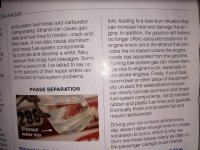Hey all,
Getting ready to install a 90gph Sierra marine water separator on my 90hp carb'd Johnson. (boat has built in tank, and is wet slipped all season) Started doing some reading and came across a few things indicating it may create a restriction in the fuel system. What is the general consensus on this? I know all the benefits of installing one, but are there many downsides?
Boat is used frequently. I add fuel probably every 2-3 days.
Should I remove the inline filter under the cowl after the sierra installation?
I know this topic has been discussed many times but in doing searches, as usual, I always seem to end up 50/50.
Thanks.
Getting ready to install a 90gph Sierra marine water separator on my 90hp carb'd Johnson. (boat has built in tank, and is wet slipped all season) Started doing some reading and came across a few things indicating it may create a restriction in the fuel system. What is the general consensus on this? I know all the benefits of installing one, but are there many downsides?
Boat is used frequently. I add fuel probably every 2-3 days.
Should I remove the inline filter under the cowl after the sierra installation?
I know this topic has been discussed many times but in doing searches, as usual, I always seem to end up 50/50.
Thanks.


